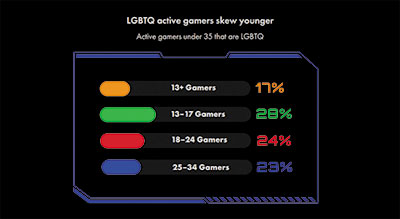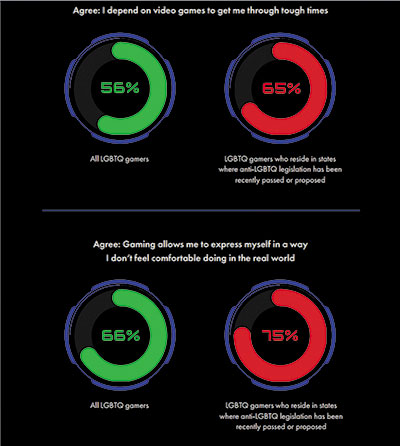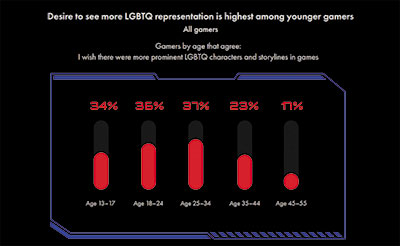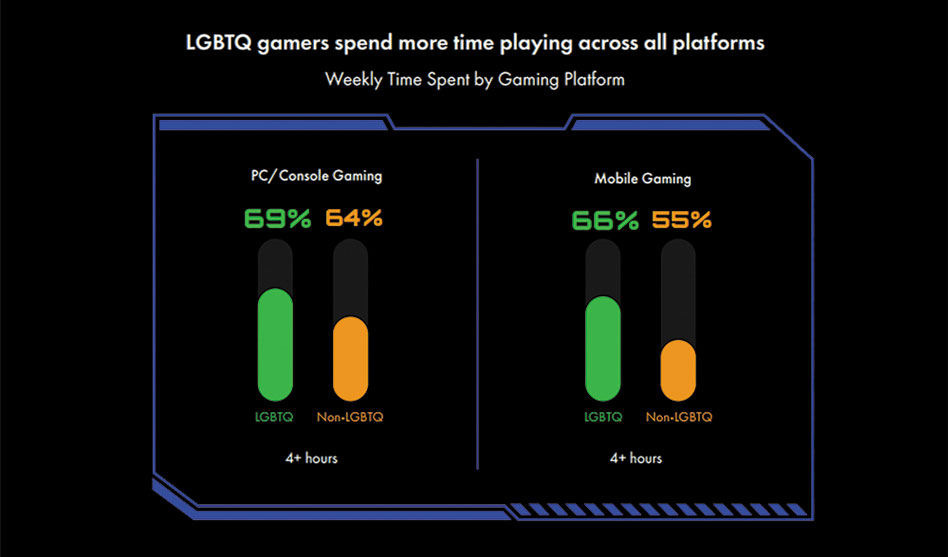All graphics provided by GLAAD
GLAAD releases inaugural gaming report
MELISSA WHITLER | NBCU Fellow
Melissa@DallasVoice.com
Earlier this year, GLAAD released their first ever Gaming Report, assessing LGBTQ inclusion in gaming. In addition to their yearly Where We Are on TV report, the organization has taken an in-depth look at LGBTQ representation in gaming for 2023.
 Their goal with this report is “to educate the game industry on the current state of LGBTQ representation that exists, make a facts-based business case for LGBTQ inclusion and provide a playbook for more authentic representation,” the report notes.
Their goal with this report is “to educate the game industry on the current state of LGBTQ representation that exists, make a facts-based business case for LGBTQ inclusion and provide a playbook for more authentic representation,” the report notes.
Blair Durkee, associate director of GLAAD’s gaming department, was the lead for the report. In an interview with Dallas Voice, she described its importance: “Gaming is very unique in that it is interactive, based on community interaction and involvement,” said Blair. “It has a different culture from film and TV, as there is an identity that is built around gaming.”
Because of this, GLAAD took a look specifically at people who identify as gamers. For the report, they surveyed 1,400 people in the U.S. who play on a PC or console for at least one hour a week. This is why their findings are somewhat unique, as they used a different population than other reports have.
Since the invention of modern gaming, global gaming revenue has grown to be on par with that of the film and music industries. So it is imperative that LGBTQ people see themselves represented in such a major part of life.
In addition, in their research with Nielsen, GLADD found that nearly one in five active gamers identified as part of the LGBTQ community.
This comes as a 70 percent increase from the 10 percent reported by Nielsen in 2020. This high of a statistic was very surprising for Durkee, and her team rechecked to ensure the number was fully accurate.
 “We think that COVID-19 pandemic had a lot to do with the increase,” Durkee said. “Gaming was a solace for many of us in the community as we sought out connection.”
“We think that COVID-19 pandemic had a lot to do with the increase,” Durkee said. “Gaming was a solace for many of us in the community as we sought out connection.”
The numbers are even higher for younger generations, as 23 to 28 percent of gamers under 35 identify as part of the LGBTQ community. LGBTQ gamers also spend more time on average playing per week than non-LGBTQ peers.
Despite these numbers, GLAAD found that games with LGBTQ characters or storylines account for less than 2 percent of all games. To get this number they relied completely on public information after reaching out to various platforms and getting no responses.
This is an extremely disappointing statistic, as video games allow for almost limitless possibilities, yet our diverse lives are not being represented. It also highlights the importance of creating such a report, as Sarah Kate Ellis, president and CEO of GLAAD, stated.
“We cannot move what we do not measure,” Ellis said.
It matters to gamers that they are able to play characters that match their gender and sexual orientation. GLAAD found that 72 percent of LGBTQ gamers say that seeing characters with their gender identity and/or sexual orientation represented well makes them feel better about themselves. This percentage is even higher for gamers in younger age groups: 78 percent for 13–17-year-olds.
Games also help players realize and come to terms with their sexual orientation and gender identity as they are able to explore options more freely than in their real lives.
GLAAD reports that LGBTQ gamers are more likely to buy games with LGBTQ representation, while only a small proportion of non-LGBTQ respondents said they wouldn’t play an inclusive game. Overall, the buying power of the LGBTQ community outweighs any losses that would result from homophobic customers.
So gaming companies not only have a moral incentive to be inclusive but a financial one as well.
 Most of the representation that has been introduced has been in secondary, non-playable characters. The GLAAD report explains that “although secondary or optional representation is not as impactful when it comes to creating meaningful LGBTQ content, such options would be profoundly meaningful for LGBTQ gamers and could pave the way for more LGBTQ inclusion. Optional representation should be seen as a starting place and not an end goal when it comes to LGBTQ inclusion in video games.”
Most of the representation that has been introduced has been in secondary, non-playable characters. The GLAAD report explains that “although secondary or optional representation is not as impactful when it comes to creating meaningful LGBTQ content, such options would be profoundly meaningful for LGBTQ gamers and could pave the way for more LGBTQ inclusion. Optional representation should be seen as a starting place and not an end goal when it comes to LGBTQ inclusion in video games.”
Not only is it important for LGBTQ people to see themselves in games, but representation can also help foster acceptance and understanding from non-LGBTQ peers.
“GLAAD’s theory of change is that seeing authentic representation has an inherent impact of normalizing and familiarizing people with our community,” Durkee said. In line with this, the report states that the findings “suggest that gamers can become more comfortable with content as they are introduced to it.”
Having more representation in games could help create more acceptance in everyday life. For younger players or those living in more rural areas, video games might be the first place they are exposed queer identities.
“Games are an opportunity to show we are everyday people, to create connection between allies and us,” said Jacob Reyes, a member of GLAAD’s communications team based in Texas. He emphasized that it is a way of learning outside of political contexts that helps others understand us even more.
For companies looking to be more inclusive, GLAAD is an incredible resource. The organization does consulting for game developers to create authentic representation and walks with companies through every step. Previously they have worked with Respawn entertainment to create
the first transgender woman character in Apex Legends.
In addition to looking at representation in gaming, GLAAD also looked at the habits and profiles of gamers. There are some notable differences between LGBTQ and non-LGBTQ gamers. GLAAD found that LGBTQ gamers are more likely to play single-player games and cooperative multiplayer games than non-LGBTQ gamers. Non-LGBTQ gamers are more likely to play competitive multiplayer games and are more likely to play shooting-based games.
While games can be a source of entertainment and escape, they can also be an outlet for self-expression. This is especially true for members of the LGBTQ community as they are 16 percent more likely to respond that they can be their true selves only while gaming. For LGBTQ youth living in unaccepting households, gaming communities might be the only space where they are able to have their identities accepted.
Multiplayer games also provide a place to connect with others and make friends. Even with harassment concerns, online gaming communities can expose young kids to other members of the LGBTQ community who share their identities.
This function of games becomes even more crucial in states with anti-LGBTQ legislation.
The report found that 66 percent of LGBTQ gamers say gaming allows them to express themselves in a way they don’t feel comfortable doing in the real world. The numbers are even higher for states that introduced anti-LGBTQ bills, and many gamers depend on video games to get them through tough times.
While we might focus on games as an outlet for fun and relaxation, we cannot ignore their use to escape and get through difficult situations in real life. As the GLAAD report states, “gaming is necessary to cope with real-world discrimination and targeting.”
Reyes said these findings line up with what he has seen in Texas. “The arts as a whole are necessary for our community, and gaming is one outlet for LGBTQ community here in Texas,” he said. “Arts and drag and entertainment are very essential for our own wellbeing.”
Reyes points to local organizations like DSQO who are using videos games as a tool to build community and safe spaces of self-expression.
Gaming especially serves as a lifeline for LGBTQ individuals of color. GLAAD found that a higher percentage of LGBTQ gamers of color reported that video games help them cope with the lack of LGBTQ acceptance in the real world, and many feel more accepted in gaming communities than where they live.
Despite the growing population of LGBTQ gamers, representation in the games themselves is lagging behind. GLAAD’s inaugural Gaming Report highlights the disparities in inclusion, as well as provides some recommendations for the industry. They call for companies to take responsibility for making communities more inclusive, to consult LGBTQ media content experts, and hire LGBTQ workers in positions of authority.
“We have a long way to go and we’re just getting started, but we hope this report is a wakeup call to the industry,” said Durkee. Because of the slow nature of the industry, we might not see the full effects of companies’ inclusion efforts for another three to four years. Still, these long overdue conversations are finally happening, and there is a path forward to improving LGBTQ representation and inclusion in the gaming industry.
This story is part of the Digital Equity Local Voices Fellowship lab. The lab initiative is made possible with support from Comcast NBC Universal and News Is Out.

